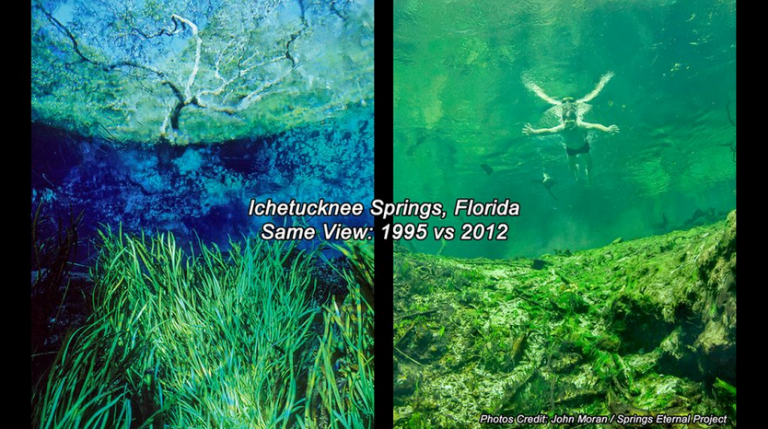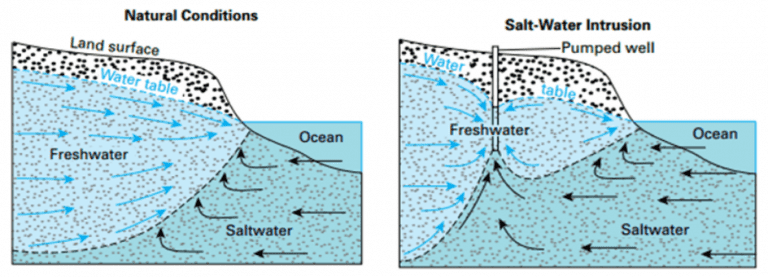On Feb. 23rd 2021, the fight for Florida’s springs took a turn. The Suwannee River Water Management District board voted in favor of renewing a permit allowing Seven Springs Water Co. to continue pumping water from Florida springs. Seven Springs, which owns Ginnie Springs and the surrounding land, pumps this water to the High Springs bottled water facility bought by Nestle in 2019.
This vote comes after decades of hotly debated corporate involvement in Florida’s natural springs. Unfortunately, it is just the most recent development in a tortured saga. Since 1998, Seven Springs has sold its water use permit to various companies. Before Nestle, Dannon, Coca Cola and Ice River all owned the High Springs water bottling facility respectively1.

Photo credit: Florida Memory State Library and Archives of Florida
Consequences of Over Pumping
The freshwater located on Seven Springs’ property is part of the larger Floridan Aquifer which houses springs across the state. The aquifer stretches into Georgia, Alabama, and South Carolina. Similar to Florida’s unique wetland Everglades, Florida’s springs system is unlike any other. Comprising over 1,000 springs, it is the largest concentration of freshwater in the world4. As a result, the effects of over pumping are felt far and wide.
Scientists and local officials are only just beginning to understand the ways in which over pumping affects the totality of Florida’s ecosystems. When the aquifers that feed the springs and rivers are excessively tapped, artesian pressures drop and surface water flow is diminished. With lower water levels comes increased concentration of nutrient pollution—fueling the algae blooms that are suffocating plant and animal life in the springs 5.

Photo credit: John Moran
Over 90 percent of the state relies on water from the underlying aquifers to meet their supply needs8. Saltwater intrusion would make the water unusable and send the state into a freshwater shortage.

Photo credit: Florida Museum
Who is Protecting Florida Springs?
District boards like the Suwannee River Management board are meant to limit degradation of Florida waterways through implementing minimum flows (MFLs)9. However, such MFLs have been reduced due to pumping by corporations. Regulations like these are put in place to balance water consumption needs with maintaining healthy waterways. However, lowering levels puts the fragile ecological equilibrium of the springs at risk.
What's Next?
One proposed solution is to charge businesses a fee for pumping water out of the springs. Apart from a one-time permit fee of $115 Nestle and Seven Springs have free access to Florida’s precious fresh water springs15, making a huge profit at the cost of already endangered local ecosystems. A water fee, while not a perfect solution, could act as a deterrent. At the very least, a fee would funnel money back into the state for spring conservation and restoration projects16 .
How To Get Involved
In a perfect world, Florida’s crystal springs and robust rivers would not have to go to battle with corporate greed. While the fight may seem far removed from daily life and behind courtroom doors, there are ways to get involved locally.
- Volunteer with or donate to one of many local organizations who protect the springs like The Florida Springs Institute, Florida Springs Council and Ichetucknee Alliance
- Contact city, county, and state representatives
- Vote for springs-friendly officials!
- Conserve water at home
Sources
- https://www.doah.state.fl.us/ROS/2020/20003581.pdf
- https://www.polk.wateratlas.usf.edu/upload/documents/Remembering_Kissengen_Spring.pdf
- http://protectpeaceriver.org/kissengen-springs/
- https://floridadep.gov/sites/default/files/Springs Fact Sheet 1.pdf
- https://ideasforus.org/toxic-algae-florida-how-to-stop-it/
- https://ideasforus.org/sea-level-rise-in-florida/
- https://www.nationalgeographic.com/science/article/partner-content-worried-about-water-floridan-aquifer
- https://www.sfwmd.gov/science-data/gw-modeling
- http://www.piecenter.com/pep/tmdl/about/
- https://floridaspringsinstitute.org/bottled-spring-water-and-corporate-responsibility/
- https://www.doah.state.fl.us/ROS/2020/20003581.pdf
- https://floridaspringsinstitute.org/bottled-spring-water-and-corporate-responsibility/
- https://floridaspringsinstitute.org/wp-content/uploads/2018/11/Springs-Conservation-Plan-final-draft-FINAL.pdf
- https://www.floridaspringscouncil.org/nestle
- https://floridaspringsinstitute.org/fla-gets-a-tiny-paycheck-as-nestle-taps-its-springs/
- https://floridaspringsinstitute.org/wp-content/uploads/2018/08/The-Case-for-Universal-Water-Fees-in-Florida_Palmer.pdf








